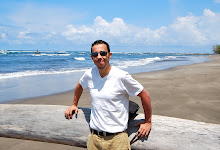Construction Boom in Panama is Built on Drug Money
By Andrew Beatty
PANAMA CITY (Reuters) - The shiny skyscrapers that soar above Panama City's coast and loom over the small Central American capital give it a skyline more suited to an Asian powerhouse like Hong Kong or Singapore.
While a subprime mortgage crisis batters the United States, construction has been booming in Panama. According to the most ambitious construction plans, Panama was to have been home to nine of Latin America's 10 tallest buildings by the end of the decade.
But the lights are off in many of the luxury apartments, new buildings sit empty, and suspicion is growing that Panama's property boom may turn out to be a bubble built by speculators on South American drug money.
Real estate agents say the large number of temporary residents in the country is the reason for the city's dim skyline at night. U.S. anti-drug officials say a more likely reason is that Colombian drug cartels use the real estate sector to launder money.
In September, when Panamanian police arrested Colombian drug lord Jose Urrego, they discovered he owned properties and businesses across Panama, including the Pacific island of Chapera, valued at around $12 million.
"It has become more difficult to transfer money through banks, so we have seen a lot more people carrying cash into Panama through Panama City airport," said a U.S. government official in Panama, who spoke on condition of anonymity.
"They launder money through the real estate sector, the banking sector and the Colon Free Trade Zone," he added, referring to Panama's import-export park.
Panama's unguarded jungle border with Colombia and its numerous coastal islands, bays and inlets have made the country a major stepping stone for the drug trade between South America, Mexico and the United States.
Its relaxed immigration laws and its good air transport links make it an easy place for Mexican and Colombian cartels to meet.
"The Colombians do not need a visa to get in to Panama, so they are increasingly using it as a place to meet, saying to their Mexican contacts, 'Let's do Panama'," the official said.
APARTMENTS ABOUND
Around 11,000 apartments are forecast to come on the market in Panama City before the end of the decade, according to estate agent Sam Taliaferro. More luxury apartments could be built in Panama over the next few years than the number built in Miami between 1995 and 2005.
All that is for a city of some 800,000 mostly poor Panamanians, some of whom live in rickety wooden homes built a century ago to house workers who built the Panama Canal.
While Panama is a major shipping route and the canal is undergoing a $5 billion expansion, the country's economy remains small and few Panamanians say developers can justify the need for so many skyscrapers.
The increasing numbers of Americans who retire in Panama head for the country's cooler mountain region, for instance.
Some pressure groups and opposition politicians accuse the Panamanian government of approving construction permits regardless of real demand because building creates construction jobs and develops the impressive skyline, photos of which adorn the country's tourist brochures.
Enrique Montenegro, head of the Anti-Corruption Front, said around a fifth of all real estate projects are bought using drug trade cash.
"Some promoters do not ask where the money comes from," he said. "Drug traffickers buy the apartments and use them for their meetings in Panama, or rent them on," he added.
"ILLICIT INVESTORS"
Panama's Attorney General, Ana Matilde Gomez, acknowledged there are "illicit investors" in Panamanian real estate but said the government was powerless to limit the skyscraper boom.
Gomez said the government's focus was on preventing money laundering in the banking sector, which in the 1980s and 1990s was a haven for drug money but has been drastically cleaned up via stricter regulation and controls on money flows.
"Outside the financial sector, there are things we cannot control. Any lucrative economic sector that is booming is attractive to ... illicit investors," she told Reuters.
Even without the suspected drug money, real estate agents say speculators are creating a dangerous bubble that is pushing up rents throughout the country, where 40 percent of the population lives on less than $2 a day, and could litter Panama City with half-finished, abandoned buildings.
Already, there are high-profile casualties.
The 104-story Ice Tower was to be one of the most prestigious addresses in the city, with projected construction costs of $200 million.
Today, its foundations are half dug and there is not a worker to be seen at the construction site.
Monday, December 31, 2007
Subscribe to:
Post Comments (Atom)

No comments:
Post a Comment